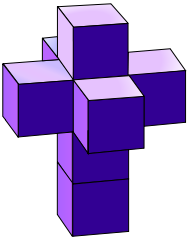Файл:Tesseract2.svg

Исходный файл (SVG-файл, номинально 188 × 239 пкс, размер файла: 11 Кб)
Этот файл из на Викискладе и может использоваться в других проектах. Информация с его страницы описания приведена ниже.
Краткое описание
| ОписаниеTesseract2.svg |
English: Image of a three-dimensional net of a tesseract, created by Dmn with Paint Shop Pro.
The net of a tesseract is the unfolding of a tesseract into 3-D space. Let the dimension from left to right be labeled x, the dimension from bottom to top be labeled z, and the dimension from front to back be labeled y. Let coordinates by (x, y, z). Let the top cube have coordinates (0,0,1), the cube below it have coordinates (0,0,0), the cube in front of it have coordinates (0,−1,0), the cube behind it have coordinates (0,1,0), the cube to the left (−1,0,0), the one to the right (1,0,0). Let the cube below the central one have coordinates (0,0,−1) and the one at the bottom (0,0,−2). The central cube (0,0,0) is seen to be connected to six other cubes, but when folded in 4-D every cube connects to six other cubes. The frontal cube (0,−1,0) connects in the −Y direction to (0,0,−2), in the +Y direction to (0,0,0), in the +X direction to (1,0,0), in the −X direction to (−1,0,0), in the +Z direction to (0,0,1), in the −Z direction to (0,0,−1). There are twelve different ways in which the tesseract can be rotated (in 4-D) by 90 degrees in such a way that four of the cubes exchange positions cyclically while the remaining four cubes stay in place but rotate (in 3-D). For example, one 4-D rotation causes the following four-cube exchange: (0,0,1)→(0,0,0)→(0,0,−1)→(0,0,−2)→(0,0,1). Meanwhile, the same rotation causes cube (0,1,0) to rotate 90 degrees around the +X axis, the (0,−1,0) cube to rotate 90 degrees around the −X axis, the (1,0,0) cube to rotate 90 degrees in the −Y direction and the (−1,0,0) cube to rotate 90 degrees in the +Y direction. The twelve 4-D rotations are: Each 4-D rotation has a "dual" which is perpendicular to the 3-D rotation of the stationary cubes. There are six pairs of dual (4-D) rotations:
The dual of a 4-D rotation implies, by means of the right-hand rule, how the stationary cubes are supposed to rotate in 3-D. Since there are eight cubes and each cube connects to six other cubes, then each cube has a pair of cubes to which it does not connect: (1) itself, and (2) its opposite. Thus there are four pairs of opposite cubes: Each pair of opposite cubes aligns itself along opposite sides of one of four orthogonal axis of 4-D space. Therefore it is possible to establish a one-to-one onto mapping f between the unfolded positions of the cubes in 3-D and the canonical coordinates of their folded positions in 4-D, viz. The canonical 4-D coordinates have been given labels corresponding to basis quaternions (and their negatives). Using these labels, the 4-D rotations can be expressed more simply as All of these rotations follow a pattern A→B→−A→−B→A, so that each one can be abbreviated as an ordered pair (A,B). Then, each rotation can be abbreviated furthest as the product of the ordered pair of quaternions, which yields an imaginary quaternion: The pairs of dual quaternions are then seen to have the following properties: the products of their single-quaternion abbreviations are always unity:
|
| Дата | |
| Источник | Собственная работа на основе: Tesseract2.png |
| Автор | Traced by Stannered |
| Другие версии | Tesseract2.png, Tesseract net Crooked House.svg |
| SVG‑разработка InfoField |
Лицензирование
| Public domainPublic domainfalsefalse |
| |
Данное произведение было добровольно передано его автором, Dmn, в общественное достояние и размещено в проекте английский Викисклад. Разрешение действует по всему миру. Если в соответствии с законодательством это невозможно, то: |
Краткие подписи
Элементы, изображённые на этом файле
изображённый объект
1 апреля 2007
История файла
Нажмите на дату/время, чтобы увидеть версию файла от того времени.
| Дата/время | Миниатюра | Размеры | Участник | Примечание | |
|---|---|---|---|---|---|
| текущий | 18:32, 1 апреля 2007 |  | 188 × 239 (11 Кб) | wikimediacommons>Stannered | tweaking top cube |
Использование файла
Следующая страница использует этот файл:







